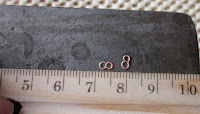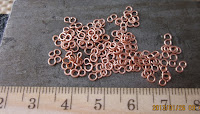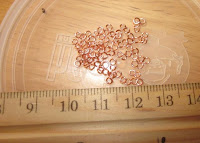I imagine that as a late period tailor I would have need for a small scale to ensure that my patrons paid using proper silver coinage. As a slightly well off merchant I would have need to keeps my books and records and so the digging began. After spending many hours researching on the internet and the library searching for period sources and references to small hand held scales I realized that I had collected over a hundred images. There are a lot of extant examples of balances from the early Roman period until well past the period that I study. I have settled on making two scales of slightly different sizes. I found the following extant examples of chains used in the construction of the balance. I have also seen version where a string was used. I like metal and wanted to do a metal project and therefore settled on a chain.
To begin with I had to decide on the materials I would use. I have very thick bronze… yuck. I also have already drawn out copper and brass wire of varying thicknesses. Many of the period references I found were either copper or copper alloy. That known, I was OK with either choice. I began a proof of concept testing phase. I mocked up some chains quickly to see how they looked and how long they might take to build well. I settled on the following two wires. I chose a thin copper wire, about 22 gauge and an 18 gauge brass wire. I would like the brass wire scale to hold up to about ½ pound of material and therefore went with a heavier gauge. This entire project is a sort of test of a theory anyway. Many of the scales I have seen are simply to weigh 5~10 coins. Some are only large enough to weigh a few coins. That is the sort of scale I'll make of the copper wire. I would like the brass one to be able to hold a larger bag. I want to see how accurate I can get the scales to work when completed and be able to weigh a year's salary on one scale.
I toyed with a variety of approaches to make these and settled on two different styles. The copper wire links are formed as a simple figure eight. The brass ones start out as a figure eight and then have a quarter twist so that the two loops are on perpendicular plains. I chose those two approaches mostly for practicality of construction and aesthetics. I was able to form that shape easy enough. After lying our a handful of options those were also my daughters two favorites and therefore they became my favorites as well.
This is another experiment. Not sure if I will use this technique or not. I tried twisting smaller wires together and then hammering them to work harden them. I like the effect of the twist, but not sure if or how to incorporate that into my design. I think I'll need some sort of decorative hook at the top and/or bottom of the chain, but not sure this approach will work for that.
Here are some photos of the various stages of the process. I basically form the small figure eight shapes with some jewelry pliers. I then snip the link off the wire and drop into a bin. Once I have a bunch in that state I then take them out one at a time and strike them with a small hammer two or three times to harden and slightly flatten them. I'm not so concerned with the hardening, the purpose of this step was primarily to flatten the link and get it ready for final shaping. After the pieces were flattened I would then take the jewelry pliers once again and with more care try and straighten out the link to ensure that it looks balanced and shaped correctly. This is the final quality check before adding it to the chain.
By the way, the ruler is in centimeters.
I found that it took 2~3 hours to create this small bin of links. Not sure exactly how much chain this will make yet. All part of the experiment. Based on the progress so far I am guessing that a six in chain will take about two hours to construct. Based on that estimate I'm looking at about 12 hours or so of time just to construct the chains. Yeah, that's about how much time I was OK committing to this project. I still have to fashion the pans and the balance arms. Was hoping the entire project would take somewhere around 40 hours or so of labor. The brass chain goes MUCH faster, but then again that is much thicker wire and easier to handle as well.
Once I had the approach down I simply made small bins of links and then assembled them all at one time.
I haven't constructed enough copper chain to do that mockup yet. Here is a proof of concept mockup with a few paper clips holding the chains together on a cardboard pan. Based on the way the chains hang, I think I either need a bigger pan, or shorter chains. Once the real pan is added, the weight of the pan should help straighten out the slack in the chain. So far so good I think.



.jpg)













